| Article ID | Journal | Published Year | Pages | File Type |
|---|---|---|---|---|
| 1459688 | Ceramics International | 2015 | 9 Pages |
An alternative to the expensive and time-consuming processing of bulk thermoelectric microgenerators (TEGs) could be the structuring of TEGs by means of screen-printing technology. In comparison with conventional TEGs made from alloys, an oxide-based semiconducting TEG could have many advantages, such as non-toxicity, thermal stability and oxidation resistance at high temperatures. Two types of thermoelectric microgenerators (TEGs) made by screen-printing on alumina substrates, one from a Ca3Co4O9 (Ca349) p-type leg and the other from a (ZnO)5In2O3 (Z5I) n-type leg, are presented. The overall performance of the devices was determined by measuring the electrical conductivity and the Seebeck coefficient of the Ca3Co4O9- and (ZnO)5In2O3-based thick-film thermopiles in the temperature range from room temperature to 500 °C. Their microstructural properties, such as grain morphology, density, phase composition and interface with the substrate, were also investigated, with the goal being to determine the optimum firing conditions for the best TEG properties. Our study defines a promising fabrication method for oxide-based thermoelectric devices and identifies the main challenges associated with microgenerator fabrication.
